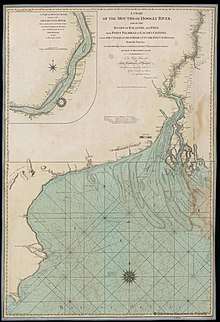Balasore Roads
Balasore Roads is a roadstead (a sheltered anchorage), on the Indian coast near Balasore. It was the location of the Bengal Pilot Service pilot boarding station (see chart). It was considered to be a generally safe anchorage, with depths varying from 5 to 15 fathoms, and with the sea bottom consisting of mud and sand.[1]

The entrance to the Hooghly River was considered to be the most difficult of any river in India[2], and the river pilot station was located in close proximity to the mouth of the river.
During the French Revolutionary and Napoleonic Wars French privateer captains such as Jean-François Hodoul and Robert Surcouf would cruise the mouth of the Hooghly River hoping to capture vessels anchored in the Roads, or proceeding to or from Calcutta. The French captured both pilot vessels such as Cartier, and large East Indiamen such as Triton.
See also
References
- Findlay, Alexander George (1866). A Directory for the Navigation of the Indian Ocean, with descriptions of its Coasts, Islands, Etc., from the Cape of Good Hope to the Strait of Sundas and Western Australia; including also the Red Sea and the Persian Gulf; the Winds, Monsoons, and Currents, and the Passages from Europe to its Various Ports. Richard Holmes Laurie. pp. 874–875.
- Wright, Gabriel (Editor) (1804). A New Nautical Directory for the East-India and China Navigation (7th Ed.). S. Couchman, London. p. 166.CS1 maint: extra text: authors list (link)